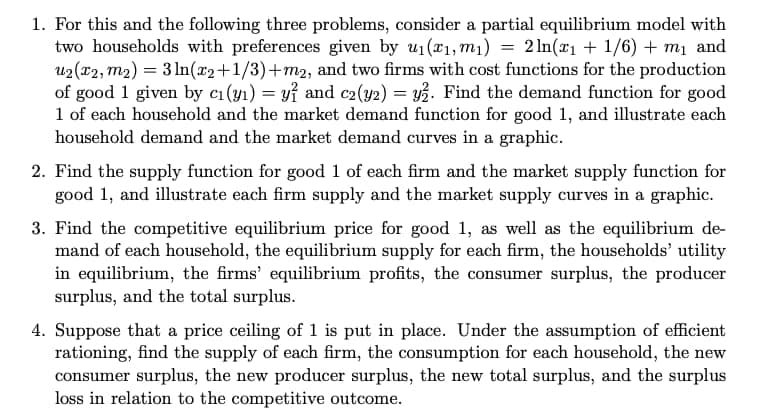1. For this and the following three problems, consider a partial equilibrium two households with preferences given by u1(x1,m1) = 2ln(xı + 1/6) u2(x2, m2) = 3 ln(x2+1/3)+m2, and two firms with cost functions for the of good 1 given by c1 (yı) = yỉ and c2(y2) = y3. Find the demand functi 1 of each household and the market demand function for good 1, and ilh household demand and the market demand curves in a graphic. 2. Find the supply function for good 1 of each firm and the market supply good 1, and illustrate each firm supply and the market supply curves in 3. Find the competitive equilibrium price for good 1, as well as the equi mand of each household, the equilibrium supply for each firm, the househ in equilibrium, the firms' equilibrium profits, the consumer surplus, th
1. For this and the following three problems, consider a partial equilibrium two households with preferences given by u1(x1,m1) = 2ln(xı + 1/6) u2(x2, m2) = 3 ln(x2+1/3)+m2, and two firms with cost functions for the of good 1 given by c1 (yı) = yỉ and c2(y2) = y3. Find the demand functi 1 of each household and the market demand function for good 1, and ilh household demand and the market demand curves in a graphic. 2. Find the supply function for good 1 of each firm and the market supply good 1, and illustrate each firm supply and the market supply curves in 3. Find the competitive equilibrium price for good 1, as well as the equi mand of each household, the equilibrium supply for each firm, the househ in equilibrium, the firms' equilibrium profits, the consumer surplus, th
Linear Algebra: A Modern Introduction
4th Edition
ISBN:9781285463247
Author:David Poole
Publisher:David Poole
Chapter2: Systems Of Linear Equations
Section2.4: Applications
Problem 23EQ:
23. Consider a simple economy with just two industries: farming and manufacturing. Farming consumes...
Related questions
Question
Q4

Transcribed Image Text:1. For this and the following three problems, consider a partial equilibrium model with
two households with preferences given by u1(r1, m1) = 2ln(x1 + 1/6) + mị and
u2 (x2, m2) = 3 ln(x2+1/3)+m2, and two firms with cost functions for the production
of good 1 given by c1 (y1) = yỉ and c2(y2) = y3. Find the demand function for good
1 of each household and the market demand function for good 1, and illustrate each
household demand and the market demand curves in a graphic.
2. Find the supply function for good 1 of each firm and the market supply function for
good 1, and illustrate each firm supply and the market supply curves in a graphic.
3. Find the competitive equilibrium price for good 1, as well as the equilibrium de-
mand of each household, the equilibrium supply for each firm, the households' utility
in equilibrium, the firms' equilibrium profits, the consumer surplus, the producer
surplus, and the total surplus.
4. Suppose that a price ceiling of 1 is put in place. Under the assumption of efficient
rationing, find the supply of each firm, the consumption for each household, the new
consumer surplus, the new producer surplus, the new total surplus, and the surplus
loss in relation to the competitive outcome.
Expert Solution
This question has been solved!
Explore an expertly crafted, step-by-step solution for a thorough understanding of key concepts.
Step by step
Solved in 5 steps with 1 images

Recommended textbooks for you

Linear Algebra: A Modern Introduction
Algebra
ISBN:
9781285463247
Author:
David Poole
Publisher:
Cengage Learning

Algebra for College Students
Algebra
ISBN:
9781285195780
Author:
Jerome E. Kaufmann, Karen L. Schwitters
Publisher:
Cengage Learning

Linear Algebra: A Modern Introduction
Algebra
ISBN:
9781285463247
Author:
David Poole
Publisher:
Cengage Learning

Algebra for College Students
Algebra
ISBN:
9781285195780
Author:
Jerome E. Kaufmann, Karen L. Schwitters
Publisher:
Cengage Learning